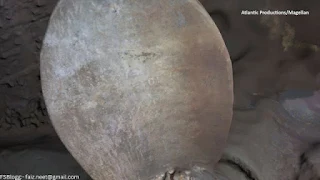Titanic's 3D scan shows shipwreck in new light
In this grab taken from a digital scan released by Atlantic/Magellan on Thursday, May 18, 2023, a view of the bow of the Titanic.
The groundbreaking achievement of deep-sea researchers has come to fruition with the completion of the inaugural comprehensive digital scan of the Titanic. This pioneering endeavor has unveiled the entirety of the wreck with an unparalleled level of detail and clarity, marking a significant milestone in the field. The companies spearheading a new documentary on the Titanic's exploration proudly announced this remarkable feat, which promises to captivate audiences with a never-before-seen perspective of the iconic shipwreck.
Deploying a pair of remotely operated submersibles, a dedicated team of researchers embarked on an extensive six-week expedition during the previous summer in the North Atlantic region. Their mission focused on meticulously mapping the entirety of the renowned shipwreck, the Titanic, as well as the expansive debris field spanning a radius of three miles. This ambitious endeavor not only involved charting the wreckage itself but also documenting the scattered remnants of personal possessions belonging to the passengers of the ill-fated ocean liner, including poignant artifacts like shoes and watches. The comprehensive exploration aimed to shed new light on the historical significance and narrative of this tragic event.
the first full-size digital scan of the Titanic wreck, showing the entire relic in unprecedented detail and clarity, the companies behind a new documentary on the wreck said Thursday.
Deploying a pair of remotely operated submersibles, a dedicated team of researchers embarked on an extensive six-week expedition during the previous summer in the North Atlantic region. Their mission focused on meticulously mapping the entirety of the renowned shipwreck, the Titanic, as well as the expansive debris field spanning a radius of three miles. This ambitious endeavor not only involved charting the wreckage itself but also documenting the scattered remnants of personal possessions belonging to the passengers of the ill-fated ocean liner, including poignant artifacts like shoes and watches. The comprehensive exploration aimed to shed new light on the historical significance and narrative of this tragic event.
Richard Parkinson, founder and chief executive of deep-sea exploration firm Magellan, estimated that the resulting data — including 715,000 images — is 10 times larger than any underwater 3D model ever attempted before.
“It's an absolutely one-to-one digital copy, a ‘twin,' of the Titanic in every detail,” said Anthony Geffen, head of documentary maker Atlantic Productions.
During its inaugural journey from Southampton, England, to New York City, the legendary Titanic encountered a fateful encounter with an iceberg in the frigid waters of the North Atlantic, precisely on April 15, 1912. The repercussions of this catastrophic collision were swift and devastating, as the opulent ocean liner succumbed to its watery grave within a matter of hours. Tragically, the toll of this maritime disaster was immense, with approximately 1,500 lives lost, forever etching the sinking of the Titanic into the annals of history.
The wreck, discovered in 1985, lies some 12,500 feet (3,800 meters) under the sea, about 435 miles (700 kilometers) off the coast of Canada.
Geffen, an expert in the field, highlights the limitations of previous depictions of the Titanic, where insufficient lighting conditions hindered comprehensive exploration, restricting viewers to one section of the wreckage at a time. However, with the advent of the new photorealistic 3D model, a groundbreaking achievement has been realized. This remarkable representation unveils a panoramic view of both the bow and stern sections, which had become disjoined during the ship's descent. Remarkably, intricate details are now discernible, including the legible serial number etched upon the propeller, providing an unprecedented level of clarity and insight into the historic vessel's fate.
After an extensive seven-month effort, the research team has diligently processed and synthesized the vast volume of data they amassed during their investigation. The culmination of their work will manifest in an upcoming documentary slated for release next year, captivating audiences with the fascinating insights unearthed from this ambitious project. However, the implications extend beyond mere documentation. Geffen expresses his aspiration that this cutting-edge technology will enable researchers to unravel intricate facets surrounding the fateful demise of the Titanic, offering a novel perspective on historical events. Furthermore, this innovative approach promises to enhance the public's engagement with history, fostering a dynamic and immersive interaction with this iconic maritime narrative.
“All our assumptions about how it sank, and a lot of the details of the Titanic, comes from speculation, because there is no model that you can reconstruct, or work exact distances,” he said. “I’m excited because this quality of the scan will allow people in the future to walk through the Titanic themselves ... and see where the bridge was and everything else.
”Parks Stephenson, a leading Titanic expert who was involved in the project, called the modelling a “gamechanger.”
“I’m seeing details that none of us have ever seen before and this allows me to build upon everything that we have learned to date and see the wreck in a new light,” he said. “We’ve got actual data that engineers can take to examine the true mechanics behind the breakup and the sinking and thereby get even closero the true story of Titanic disaster.”



.jpg)
.jpg)
Comments
Post a Comment